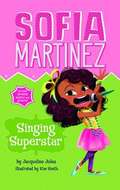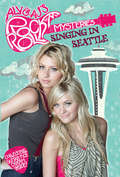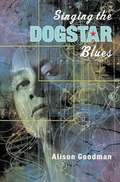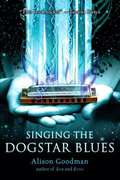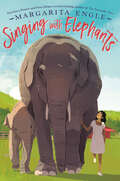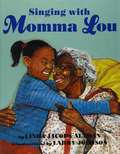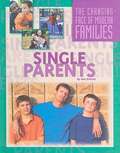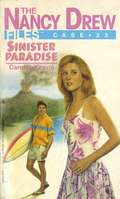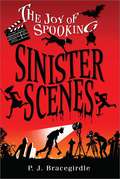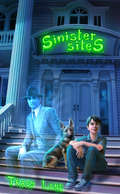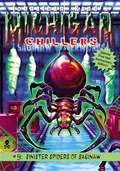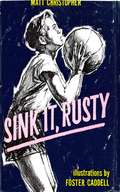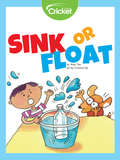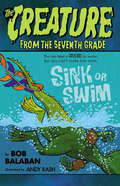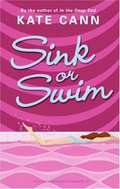- Table View
- List View
Singing Superstar (Sofia Martinez Ser.)
by Jacqueline Jules Kim SmithSofia's family does not want to hear her singing anymore, so she must find the appropriate place to use her new superstar-sing box machine.
Singing for Mrs. Pettigrew: Stories and Essays from a Writing Life
by Michael MorpurgoEvery writer's way to becoming a writer is unique, I am sure, though perhaps we all have much more in common than we believe. My way will not be the only way, but it is my way, and I hope it might be interesting and maybe even useful and encouraging to tell the story of how I became the writer I am.
Singing in Seattle (Aly & AJ's Rock 'n' Rolly Mystery #3)
by Tracey West Katherine NollAly and AJ are off to Seattle to judge a songwriting competition. The winner will have the song performed by Aly and AJ at their concert. <P><P>They hear some good songs and some bad songs, but things really hit a sour note when a contestant's notebook filled with song lyrics is stolen. Will Aly and AJ be able to crack the case?
Singing the Dogstar Blues
by Alison GoodmanSeventeen-year-old Joss is a rebel--the daughter of a famous newscaster and a sperm donor; a wild girl who can play a mean harmonica; a student of time travel at the prestigious Centre for Neo-Historical Studies. This year, for the first time, the Centre has an alien student. Mavkel, from the planet Choria, has chosen Joss--of all people--as his study partner. Can this very different pair manage to live together, much less learn from each other? "Singing the Dogstar Blues" is a genre-breaking mix of humor, science fiction, and adventure that will keep readers riveted.
Singing the Dogstar Blues
by Alison GoodmanSeventeen-year-old Joss is a rebel, and a student of time travel at the prestigious Centre for Neo-Historical Studies. This year, for the first time, the Centre has an alien student? Mavkel, from the planet Choria. And Mavkel has chosen Joss, of all people, as his roommate and study partner. Then Mavkel gets sick. Joss quickly realizes that his will to live is draining away. The only way she can help Mavkel is by breaking the Centre?s strictest rules . . . and that means going back in time to change history.
Singing with Elephants
by Margarita EngleA powerful novel in verse from Newbery and Pura Belpré Award-winning author Margarita Engle about the friendship between a young girl and the poet Gabriela Mistral that leads to healing and hope for both of them.Cuban-born eleven-year-old Oriol lives in Santa Barbara, California, where she struggles to belong. But most of the time that's okay, because she enjoys helping her parents care for the many injured animals at their veterinary clinic. Then Gabriela Mistral, the first Latin American winner of a Nobel Prize in Literature, moves to town, and aspiring writer Oriol finds herself opening up. As she begins to create a world of words for herself, Oriol learns it will take courage to stay true to herself and do what she thinks is right--attempting to rescue a baby elephant in need--even if it means keeping secrets from those she loves. A beautifully written, lyrically told story about the power of friendship-- between generations, between humans and animals--and the potential of poetry to inspire action and acceptance. * "Replete with lovely, nearly magical imagery...Brilliant, joyful, and deeply moving." -Kirkus, starred review * "Employing immersive free verse that conveys themes of compassion, friendship, justice, and vulnerability, Engle captures how inexplicable Oriol&’s grief feels, encasing it in a powerful, charitable, and brave young voice." -Publishers Weekly, starred review * "A novel written in verse that sings in your heart." -Pura Belpré Award-winning author Marjorie Agosín
Singing with Momma Lou
by Linda Jacobs Altman Larry JohnsonNine-year-old Tamika Jordan dreads visiting her grandmother at the nursing home. Momma Lou has Alzheimer's and always forgets who Tamika is. After her father shows her Momma Lou's scrapbooks, Tamika comes up with an idea to jog Momma Lou's memory. Tamika is successful in reaching her grandmother one day when Momma Lou recognizes a newspaper clipping of a Civil Rights demonstration and leads everybody in a celebration of song. Linda Jacobs Altman tells a moving story of intergenerational love and hope, while Larry Johnson's evocative paintings bring this memorable story to life. This a book to be shared by the whole family. Altman learned about the effects of Alzheimer s when her mother was stricken with the disease. While it was a tragic experience, she learned from her mother the power of the human spirit.
Single Parents (The Changing Face of Modern Families)
by Rae SimonsToday society has many different kinds of families, and the challenges they face are all unique. The real-life families in this series offer their thoughts about what they have learned from their situations.
Single Parents Families
by Rae SimonsMaybe you've heard the statistics about children growing up in single-parent families. According to a lot of the research, these kids are more likely to struggle in school, have difficulties with the law, and deal with drug and alcohol abuse-along with other problems. But does growing up with a single parent have to mean these things will happen? Are these children going to lead worse lives than those with two parents? This book tells the stories of several single-parent families, their struggles, and the things they have learned from their situations. These families are not concerned with the statistics, but with making their families and themselves the best they can be.
Singularity
by William SleatorSixteen-year-old twins Harry and Barry stumble across a gateway to another universe, where a distortion in time and space causes a dramatic change in their competitive relationship.
Sinh Ani Sasa
by P. G. SahasrabuddheOne day an old rabbit saves itself and all the other animals from a lion by making him jump in the well. The lion was supposed to eat the rabbit. But the rabbit tells him about another lion in the jungle. The lion gets angry and goes to see it. He sees his own image in the water and jumps into the well.
Sinh Ani Sinhin
by T. T. SawantThere was a big forest on the top of the mountain. A lion and Lioness decided to live in a cave. they were happy in a jungle.
Sinha Ani Mulaga
by Vishal TaydeThere was a boy looking after a cow. The boy gets lost and he goes searching for it. In the jungle a lion attacks the boy. The boy takes shelter on a tree for two days the lion waits under the tree to pounce on him. Four hunter come with guns and kill the lion and rescues the boy.
Sinhala Chakavile
by L. G. ParanjapeA Lion lived in a jungle. He was cruel and giving a lot of trouble to other animals in the jungle. One day Jungle committee of animals had decided that each of animal to went lion cave every day. Later the fox turn came. He thought a trick and lion killed.
Sinhobachi Phajiti
by Vishal TayadeThere was only one animal who was not afraid of the lion. The lion together with other animals plans to attack him. The elephants were strong and fling the lion away with his trunk and all the other animals run away. The lion tells his fellows not to give this news to other animals in fear of shame. But somehow the news spread in the jungle about the defeat.
Sinister Paradise
by Carolyn KeeneIn Hawaii, Nancy Drew investigates when Lisa Trumbull, granddaughter of millionaire Alice Faulkner, is kidnapped, and a ransom note demands that the Faulkners sell their shares of Windward Bancorp to the mysterious Malihini Corporation.
Sinister Scenes
by P. J. BracegirdleJoy Wells is thrilled when Spooking--the terrible town on the hideous hill--is chosen as the location for a horror movie. She's convinced the attention will finally prove that legendary author E.A. Peugeot set his creepy tales in her beloved hometown. And when a temperamental young starlet goes missing, Joy steps in to co-star alongside rock icon Teddy Danger. But Danger is delivering a terrifying performance that is entirely unscripted: Having rented a sinister old mansion in town, the aging musician has been possessed by a slumbering evil. In order to survive, Joy must turn once again to her old nemesis, Mr. Phipps. Old grudges and ancient curses collide as the true history of the terrible town is finally revealed.
Sinister Scenes
by P. J. BracegirdleJoy Wells encounters new horrors in the terrible town on the hideous hill in the final installment of the Joy of Spooking trilogy.Joy Wells is thrilled when Spooking--the terrible town on the hideous hill--is chosen as the location for a horror movie. She's convinced the attention will finally prove that legendary author E.A. Peugeot set his creepy tales in her beloved hometown. And when a temperamental young starlet goes missing, Joy steps in to co-star alongside rock icon Teddy Danger. But Danger is delivering a terrifying performance that is entirely unscripted: Having rented a sinister old mansion in town, the aging musician has been possessed by a slumbering evil. In order to survive, Joy must turn once again to her old nemesis, Mr. Phipps. Old grudges and ancient curses collide as the true history of the terrible town is finally revealed.
Sinister Sites
by David M. F. Powers Natalia Nesterova Tracy LaneAs far as Jake Weir is concerned, he's living the high life. Paranormal Properties, his parents' ghost-hunting show, has been picked up by the popular Scream Channel, and if their new high-rise apartment on San Francisco Bay is anything to go by, the future is definitely looking bright. However, that future depends on one important thing: the success of Paranormal Properties' first official episode. If Jake and his family can prove themselves with an exciting, successful premiere, they get to stay with the Scream Channel - if not, well, Jake doesn't want to imagine going back to the desperate life they used to live. To succeed, the Weirs are going to have to tackle their biggest case yet.Old, infamous, and abandoned for decades, the Balthazar Hotel is thought to be the eternal prison of its inhabitants, victims of a terrible fire that nearly destroyed the hotel in 1921. The Balthazar holds many secrets, and many memories, and as the Weirs investigate the mysteries surrounding the hotel in a race to complete the first episode, they quickly learn that things are much more complicated, and more dangerous, than they seem. Even with the help of his obstinate best friend Tank, and the fearless gangster ghost Frank Barrone, Jake starts to wonder if saving Paranormal Properties is worth it, if they may not even get out of the Balthazar Hotel alive.
Sinister Spiders of Saginaw (Michigan Chillers, #9)
by Jonathan RandMom had just left the kitchen, and I returned to my homework. I had my nose in a book, and was double-checking the answers on my math paper. We were going to have a quiz today. Ug. I felt a light tickling on my ankle, and I looked down. It was a spider! Not a big one, mind you--but that didn't matter. It was a spider, and it was crawling on me.
Sink It, Rusty
by Matt ChristopherAfter recovering from Polio, a disease that left his legs weak, Rusty is worried that he won't be able to play basketball. Then Alect comes to town and starts a local basketball team. Will Rusty be able to help Alec's team win their games?
Sink or Float
by Amy TaoWill an orange float or sink in water? Are heavier objects able to float in water versus lighter objects? Learn about the density of materials and how water affects the objects! Make your own scientific discoveries and expand your knowledge by conducting your own experiments with water.
Sink or Swim
by Bob Balaban Andy RashThere's a thief in town, and all signs point to twelve-year-old Charlie Drinkwater. Once you spontaneously morph into a giant mutant dinosaur in the middle of the school day, people will suspect you of just about anything. Charlie's teachers decide that all he needs is a little discipline, so they make him join the swim team. The only problem is, Charlie is terrified of the water. (He's terrified of a lot of things.) Charlie and his friends vow to apprehend the real criminal and clear Charlie's name. But when they discover who the actual thief is, Charlie's problems get a whole lot bigger . . . not to mention slimier, scalier, and smellier!
Sink or Swim
by Kate CannI sat back on my bed, heart hammering. So that's what I was. A friend. You weren't my friend, Art. You were my lover. Friends make you laugh and support you and stop you feeling alone. They don't make you go to bed night after night curled up in misery. You're not my friend.
